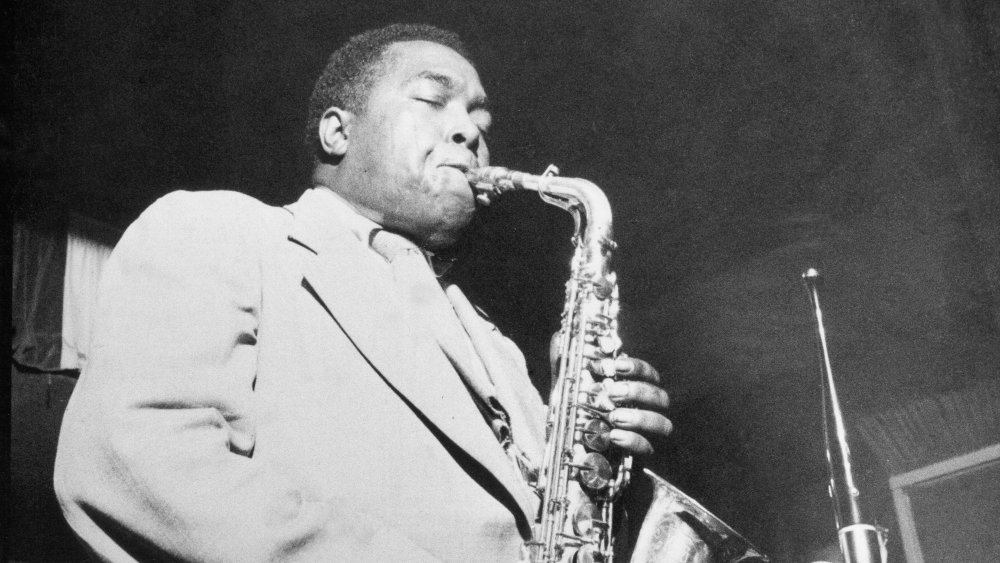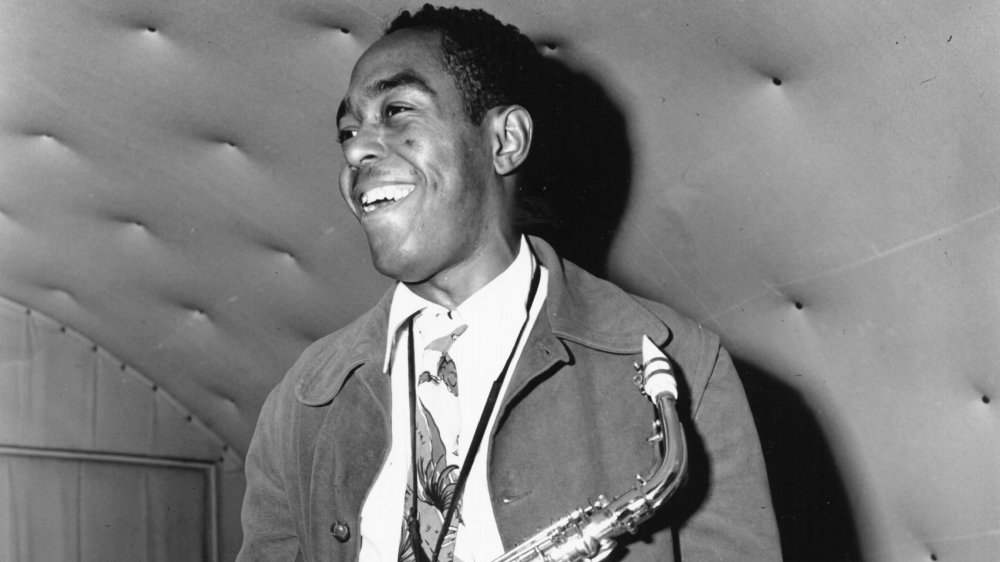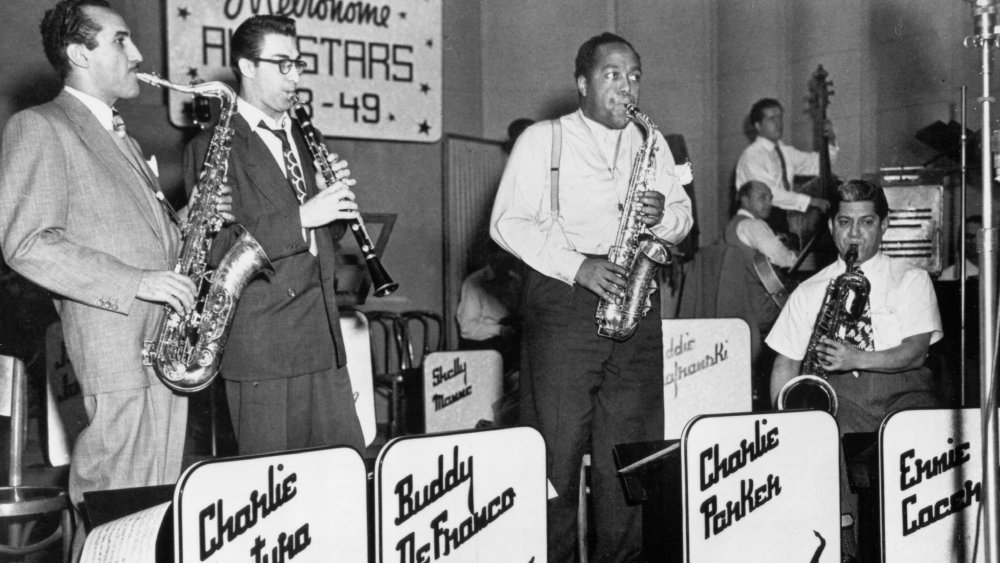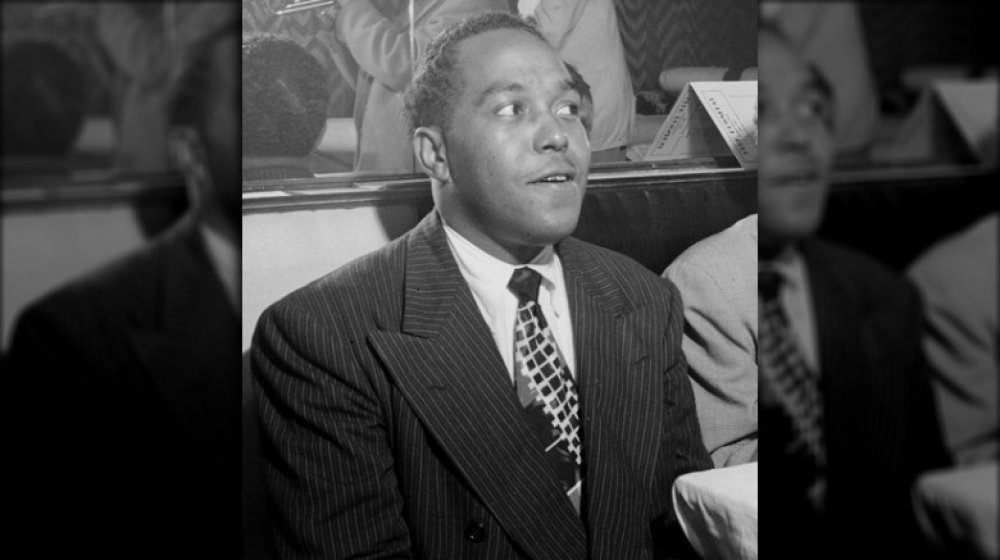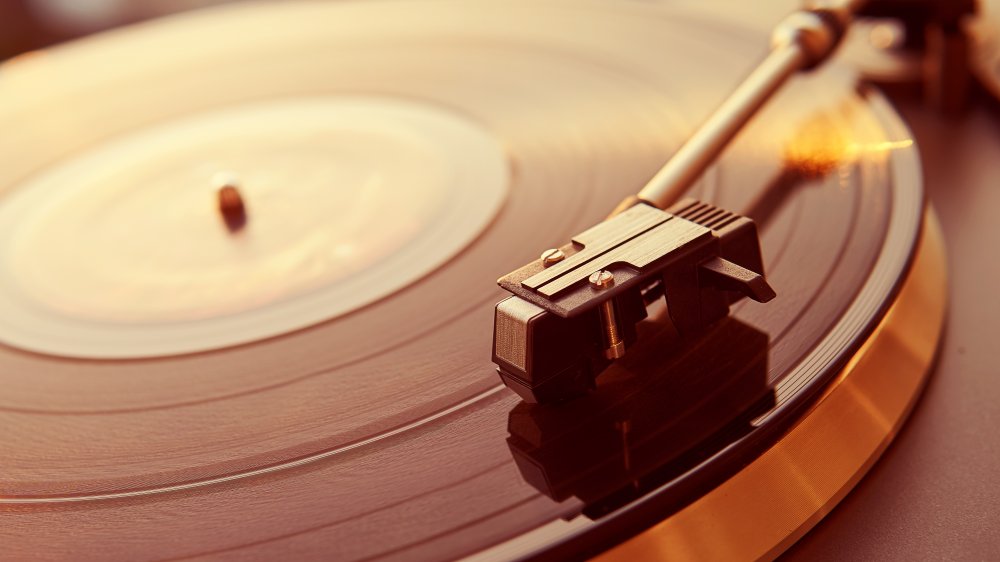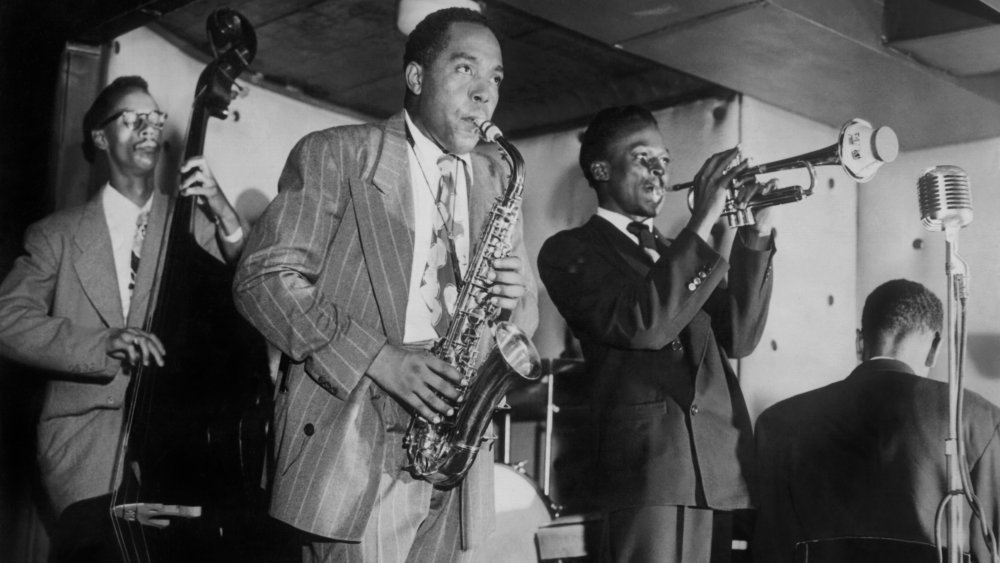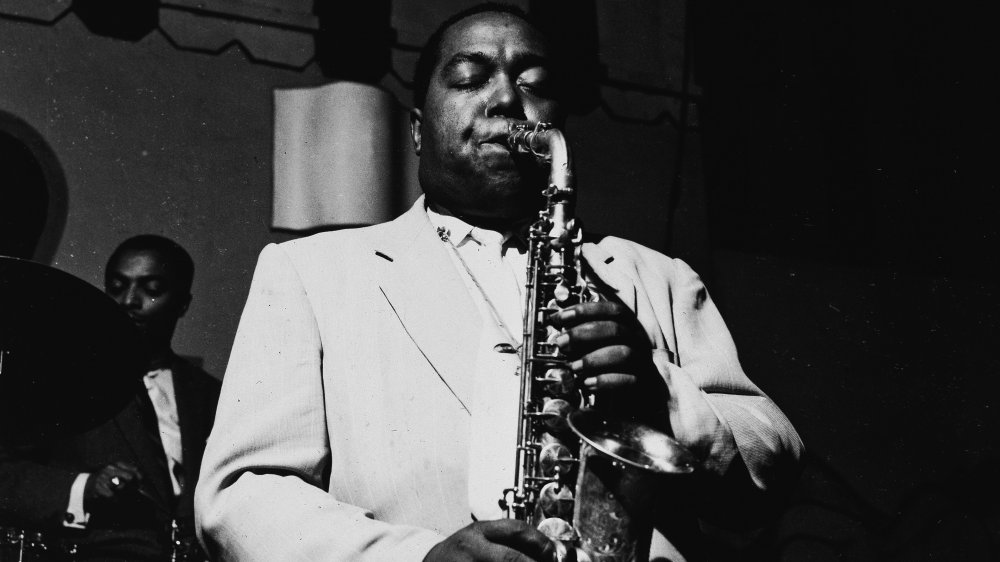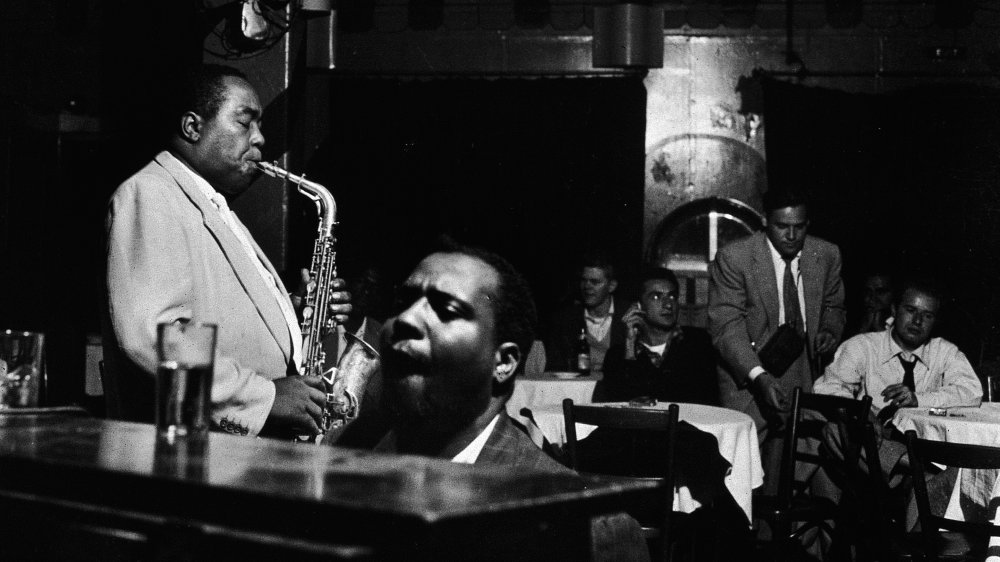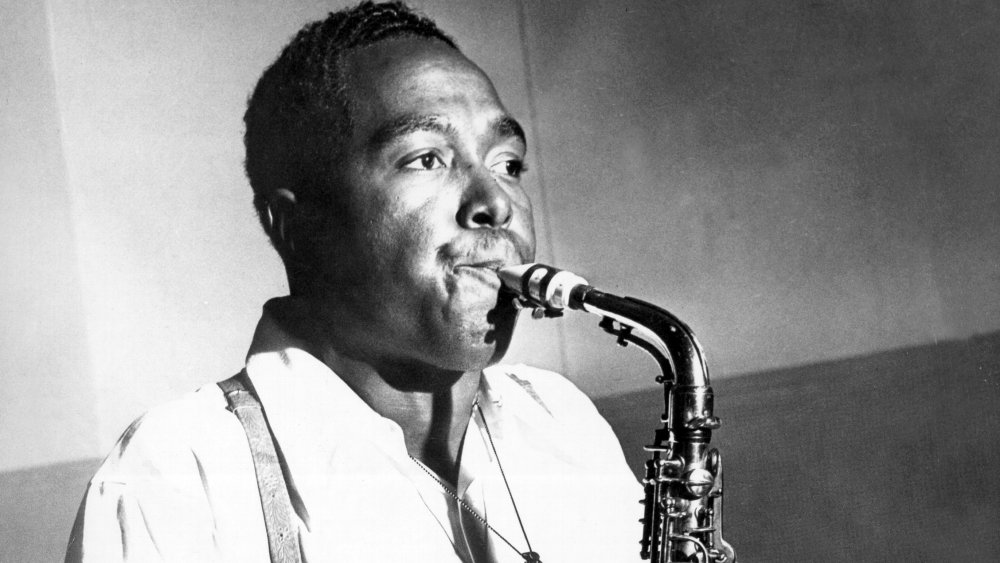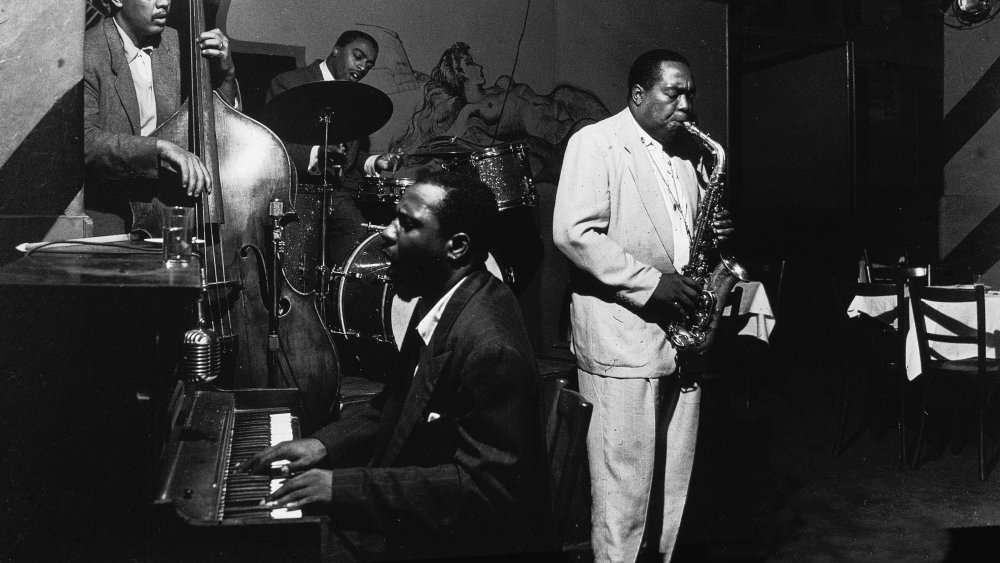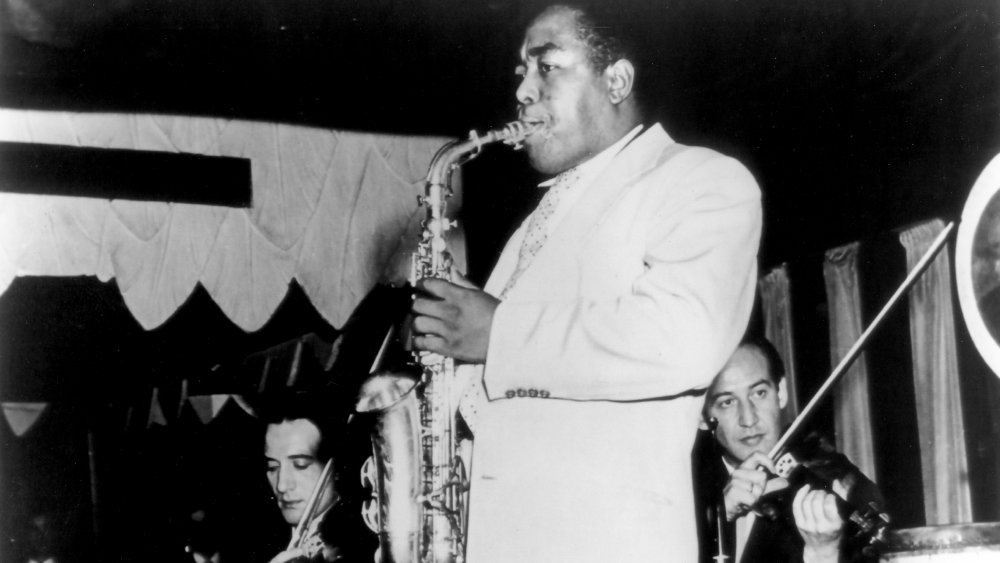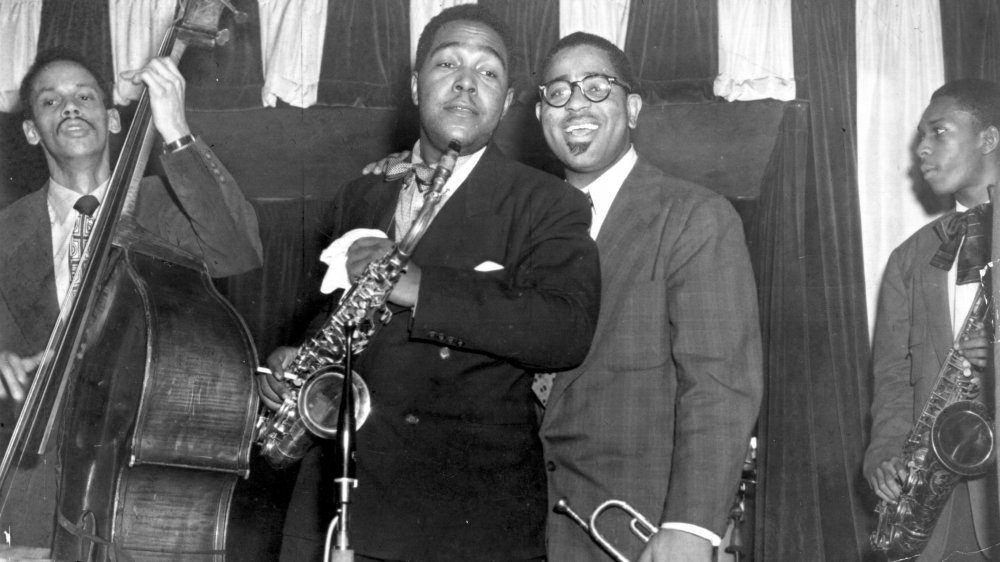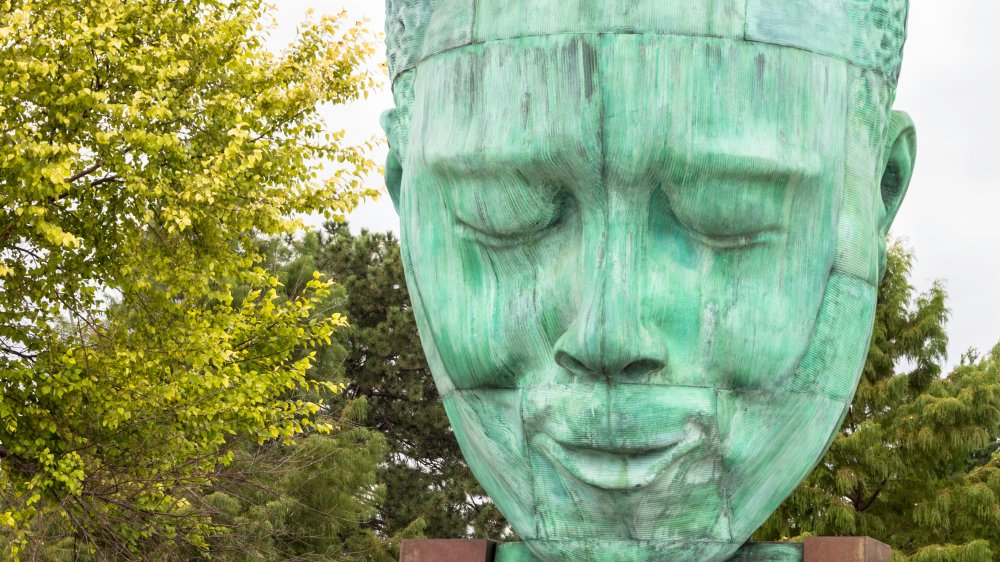The Tragic Real-Life Story Of Charlie Parker
Groundbreaking jazz saxophonist and composer Charlie Parker has his handprints all over the development and sound of modern jazz. Known by his nickname "Yardbird" or even just "Bird," Parker is best known as one of the pioneering founders of the style known as bebop. He was a true genius at his instrument, forever altering this most American of music forms by injecting completely new forms, methods, and ideas into its DNA.
But like so many of the most innovative virtuosos in American music, Parker's life was tragically brief. Along with the challenges and dangers of growing up Black during one of the more particularly racist and violent periods of American history, Parker's sweeping role in the jazz and hipster movements brought with it the drug and alcohol abuse shared by so many others in the same circle. And as with his approach to music, Parker pursued these with a fervor that would lead to his life being cut dramatically short.
Charlie Parker didn't have much of a childhood
Charlie Parker was born August 29, 1920, in Kansas City, Kansas, but was raised in Kansas City, Missouri. His father Charles Parker Sr. worked as a janitor, and his mother Adelaide was a homemaker. Not much is known about Parker's early childhood. As stated by The New York Times, the Kansas City area was already a hub for distributing drugs like cocaine, morphine, and heroin throughout the Southwest. According to Bird: The Life and Music of Charlie Parker, Charles Sr. often spent long periods away from home, drinking and spending time in nightclubs. He and his wife separated in 1924, reconciled, but later split for good in '32.
After Charles Sr. and Adelaide separated for good, she began working late nights as a custodian and taking in boarders to make ends meet. This left the young Charlie to wander the streets, hanging out in the alleyways behind nightclubs, playing music late into the night, and encountering drugs early on, according to Bird Lives. He became dedicated to practicing his alto sax early (the first one was carried in a case his mother sewed for him using pillow fabric) but was described as fairly antisocial and lonely.
Charlie Parker was single-minded in his dedication to music
Parker got his first alto sax at age 12 and reportedly started putting in 11 to 15 hours of practice a day. He was so dedicated that by the age of 15, he was a professional working musician with membership in the musicians' union. It soon became clear that music was his only real driving force, so he withdrew from high school and threw even more energy into mastering the sax, according to Charlie Parker: His Music and His Life.
While he was known from a fairly early age for his music skills, Parker was nonetheless dealt a blow to his ego when he was still fresh on the jazz scene. As told by The Guardian, in 1937, the teenaged Bird waited with other hopeful musicians outside Kansas City's Reno Club, eager to get time jamming onstage with Jo Jones, the drummer for Count Basie — one of the single biggest names in swing at the time. The 16-year-old Parker came as prepared as he possibly could: a new saxophone and inventive techniques of using unusual keys and modulations.
At first, the session was going well, but while trying another of his improvisational key changes, Parker lost the beat and the tune. Jones reportedly took his cymbal off the kit and threw it at Parker's feet to loud catcalls, humiliating him and signaling for him to leave. As crushing as this must have been, it inspired Parker to work even harder at the saxophone. Soon, he'd be recognized for his innovation and talent.
A terrible car accident pushed Charlie Parker deeper into drugs
In 1936, at the age of 16, Parker very nearly lost his life, as detailed in Charlie Parker. Parker was headed to a Thanksgiving performance in the Ozarks with a caravan of other musicians when they were involved in a near-fatal car accident. Another passenger was hospitalized, and a third was killed in the collision. Parker broke three ribs and fractured his spine. At the time, there was major concern over whether Bird would be able to walk again, let alone keep playing saxophone in nightclubs. The crash turned out to have profound effects on the direction Parker's life took afterward. Insurance settlement money enabled Yardbird to buy a new saxophone, but this would soon be pawned for cash.
Recovery from the crash took Parker a long time, stretching into 1937. Painkillers prescribed by the doctors, including morphine, ended up creating a dependency in Parker that would last for the rest of his life, according to Bird. Though he claimed to have first tried heroin at 15, it was believed by his wife Rebecca that the prescribed drugs greatly exacerbated the problem. Heroin allowed Bird to get a break from the pain of his broken bones and focus on innovating with the saxophone some more. His skill and groundbreaking jazz discoveries seemed to increase in tandem with his drug use.
Some of Charlie Parker's earliest bebop sessions weren't documented
The birth of bebop revolutionized jazz and was largely steered by Charlie Parker, alongside fellow jazz pioneer, trumpeter Dizzy Gillespie. Other jazz legends like Thelonius Monk would regularly experiment and collaborate with the musical innovators. But at the same time this new and lasting take on the genre was forming, the music recording industry had hit stumbling blocks.
During the early '40s, a series of disputes between the American Federation of Musicians and the various recording companies resulted in a strike, according to The New York Times. This meant that very few new recordings of any kind were being made, hitting jazz particularly hard. Gillespie and Parker were rarely recorded during this period of musical genesis. According to the American Federation of Musicians, the strike lasted two years. While the strike was ultimately a very good thing for musicians overall — it resulted in the establishment of a royalty on record sales to pay musicians for live performances — these missing sessions only add to Parker's legend.
Alcohol also played a heavy role in Charlie Parker's life
Charlie Parker was known for mythic levels of excess in every area: food, sex, drugs, and alcohol. There are tales of Bird eating 12 hamburgers in one sitting or two or three massive Mexican dinners backstage immediately before a performance, as noted in The New Yorker. During a stay in California, Parker's heroin dealer was arrested, and the withdrawal symptoms were so bad that Parker leaned even harder into alcohol, according to Charlie Parker.
Before a recording session for the new independent record label Dial in 1946, he drank a quart of whiskey and severely fumbled his parts. The most astounding part is that even with the missed cues and other mistakes, some consider this session to have produced the best recording of the song "Lover Man." Parker apparently hated that the recording was released, because it was a reminder of the nervous breakdown he had the day after the session. This collapse extended Parker's stay in California when he was committed to a state mental hospital.
Charlie Parker was committed on more than one occasion
In 1945, Charlie Parker was making serious waves, recording bebop music with legends like Miles Davis and Dizzy Gillespie. According to The New Yorker, that same year, Parker went to California with the iconic first great bebop band, made up of himself, Gillespie, Max Roach, and others. By this point, Parker's heroin dependency had already begun to disrupt practice and performances, though, by all accounts, his heavy drug and alcohol use never got in the way of his playing.
The journey from New York to Los Angeles was delayed when the 25-year-old Parker ran out of heroin and went into withdrawal, according to Bird. The rest of the band eventually returned to New York, but Parker cashed in his return ticket for heroin and stayed behind in California. Though they would remain lifelong friends, this effectively ended the creative partnership between Gillespie and Parker.
In 1946, Parker collapsed the day after the ill-fated Dial session and was put in the Camarillo State Mental Hospital, where he remained for six months, according to Charlie Parker. While he was there, doctors treated him with contempt, noting that he would be in prison if not for his musical skill and regarding the young artist as more of a curiosity than a patient. Parker came out sober and even wrote a song about the experience, complete with the tongue-in-cheek title "Relaxin' at Camarillo." But by his return to NYC, Bird was already back on heroin.
Charlie Parker was frequently victimized by police and the music industry
It's no surprise that a Black musician living in this period of American history would experience frequent racism, harassment, and even violence, even someone as high-profile as Charlie Parker. Interestingly, for much of his life, Parker had a cynically amused attitude toward police, according to Bird. He was able to bribe police officers when pulled over for speeding, but he wasn't always lucky.
The restrictions of the Cabaret Card, a license musicians needed to perform in nightclubs, placed Parker under the jurisdiction of the NY Liquor Authority and the Narcotics Squad. According to The New York Times, Parker's card was revoked after a narcotics search which, perhaps surprisingly, turned up nothing. He was subjected to degrading searches and, without the Cabaret Card, couldn't work to support his family. This led to him bringing his family directly to the Welfare Board and demanding, "Here! You feed them."
And it wasn't just the law that had it out for Parker. While America continued to eat up popular records from Black musicians, the music industry continued to exploit and cheat them at every available turn. The New York Times notes that bad contracts were frequently leveraged against new or inexperienced artists (the Bop classic "Now's the Time" was apparently sold for $50). Parker was at a greater disadvantage because he didn't have the financial or even material resources to fight for a better deal or find other avenues for his work.
Charlie Parker's relationships tended to be difficult and short-lived
It's not unusual for the high-octane (and frequently low-paying) lifestyles of artists to seriously damage their romantic lives. In this respect, Parker often seemed to show the same reckless abandon that he did with substances, food, and alcohol — in all, there were four marriages, with varying and dubious degrees of legality.
Parker's first marriage was to his high school sweetheart Rebecca Ruffin at the age of 16, but he left home (and family) for New York at age 20, according to PBS. His second marriage to Doris Sydnor in 1948 may have also been his last legal one, according to Charlie Parker, and it's likely he never actually divorced Ruffin. In 1950, he started living with Chan Berg, his common-law wife and eventual mother of two of his children, Pree and Baird. Because of his tangled web of wives, the process of settling Parker's estate after his untimely death was long and difficult.
Charlie Parker was pushed over the edge by personal tragedy
In March 1954, Charlie Parker's drug use was once again interrupting his ability to get a paycheck. Erratic behavior and arguments got him fired from two jobs in one week, according to The Guardian. Shortly after the second firing, Parker received word that his three-year-old daughter, Pree, had died. One of Parker's two children with Chan Berg, Pree was born with a congenital heart defect and passed away after being hospitalized during a long struggle with pneumonia.
At the time, Parker was staying in Los Angeles. Upon receiving word that his daughter was dead, he drank heavily and sent a series of desperate telegrams to Chan before getting rid of his alcohol and heroin and returning to New York. The loss of Pree soon drove Bird to drink even heavier than before, and he attempted suicide by drinking iodine that year. Soon, he was again moved to a mental hospital, this time New York's Bellevue, and never returned to California. Within 12 months, he would be dead.
If you or anyone you know is having suicidal thoughts, please call the National Suicide Prevention Lifeline at 1-800-273-TALK (8255).
Charlie Parker died young under strange circumstances
It's safe to say that Charlie Parker never fully recovered from the loss of his daughter. The final year of his life was a steep and continued decline. Parker's alcohol and drug abuse became worse by the day, and he made his final recordings while confined in Bellevue, according to The Guardian. Almost exactly a year after Pree's death, the accumulation of health problems brought by such hard living as Bird's finally became too much. He died while staying in the hotel suite of a wealthy friend and benefactor, Baroness Pannonica de Koenigswarter. It was said that a thunderclap coincided with the moment of his passing, according to Bird: The Life.
The official cause of Parker's death was pneumonia and a bleeding ulcer, but he'd also had a heart attack and had been staying in the baroness' suite for several days prior to his death to recover from other illness. According to PBS, the coroner mistakenly believed he was between 50 and 60 years old, but he was only 34 when he died.
Arranging Charlie Parker's funeral was messy
In the wake of Charlie Parker's sudden, if not totally unexpected, death, complications began to arise immediately between the saxophonist's former wives. According to Bird: The Legend, Chan wanted to honor Parker's wish of a small, humble funeral and to not be buried in Kansas City, but Doris Parker soon arrived and began arranging for the opposite. The large lying-in-state and public viewing was met with mixed responses from Parker's friends and family, according to Bird: The Life. A song called "The Lost Chord" that played during the service was scoffed at, as Parker's peers and fans said Bird never lost a chord.
Parker died essentially broke, with nothing but a $1,000 life insurance policy for his family. When it was time to ship his body back to Kansas for burial (against Parker and Chan's wishes but in keeping with his mother's), close friend and collaborator Dizzy Gillespie offered to help pay for the cost of shipment. Benefit concerts and memorial albums soon began to spring up with the hope of establishing a trust fund for Parker's children, but the heavy hand of the record companies would ensure that little money actually made its way to the family.
Charlie Parker's death made a huge impact, but not always in a good way
After Charlie Parker died, legions of hipsters and beats mourned publicly, taking to the streets and writing messages like "Bird Lives" all over public spaces for weeks afterward, according to Bird: The Legend. While the music world grieved Parker's passing and his legendary stature ballooned even further overnight, very little of Bird's success would be translated into financial security for his family. Chan remarked at his funeral that some of Parker's pallbearers had been the same people who took advantage of him financially, and this, unfortunately, proved to be the case as the legal complexities of Parker's estate continued to unwind. Out of the string of memorial concerts and albums after he died, none of the money went to his kids or wives, and his mother received maybe $500 in all, according to Bird Lives.
Though he showed little restraint or caution in his own life, Charlie Parker wanted to stop younger musicians from idolizing him, especially when it came to his heroin habit. But the opposite ended up happening, and new waves of jazz musicians continued to gamble with heroin in pursuit of becoming the next Bird. His legacy, like his estate, relationships, and health, remains as complicated and fascinating as the bold improvisations he delivered with his sax.
